Surface Soil Moisture Retrieval Using Sentinel-1 SAR Data for Crop Planning in Kosi River Basin of North Bihar
Abstract
:1. Introduction
2. Materials and Methods
2.1. Study Area Description
2.2. Satellite Data Used & Pre-Processing
2.3. In-Situ SSM Measurements
2.4. Method for Modeling SSM
3. Results
3.1. Measured Surface Soil Moisture
3.2. Modeled Surface Soil Moisture and Comparisons with In-Situ Measurements
4. Discussion
5. Conclusions
Author Contributions
Funding
Institutional Review Board Statement
Informed Consent Statement
Data Availability Statement
Acknowledgments
Conflicts of Interest
Appendix A
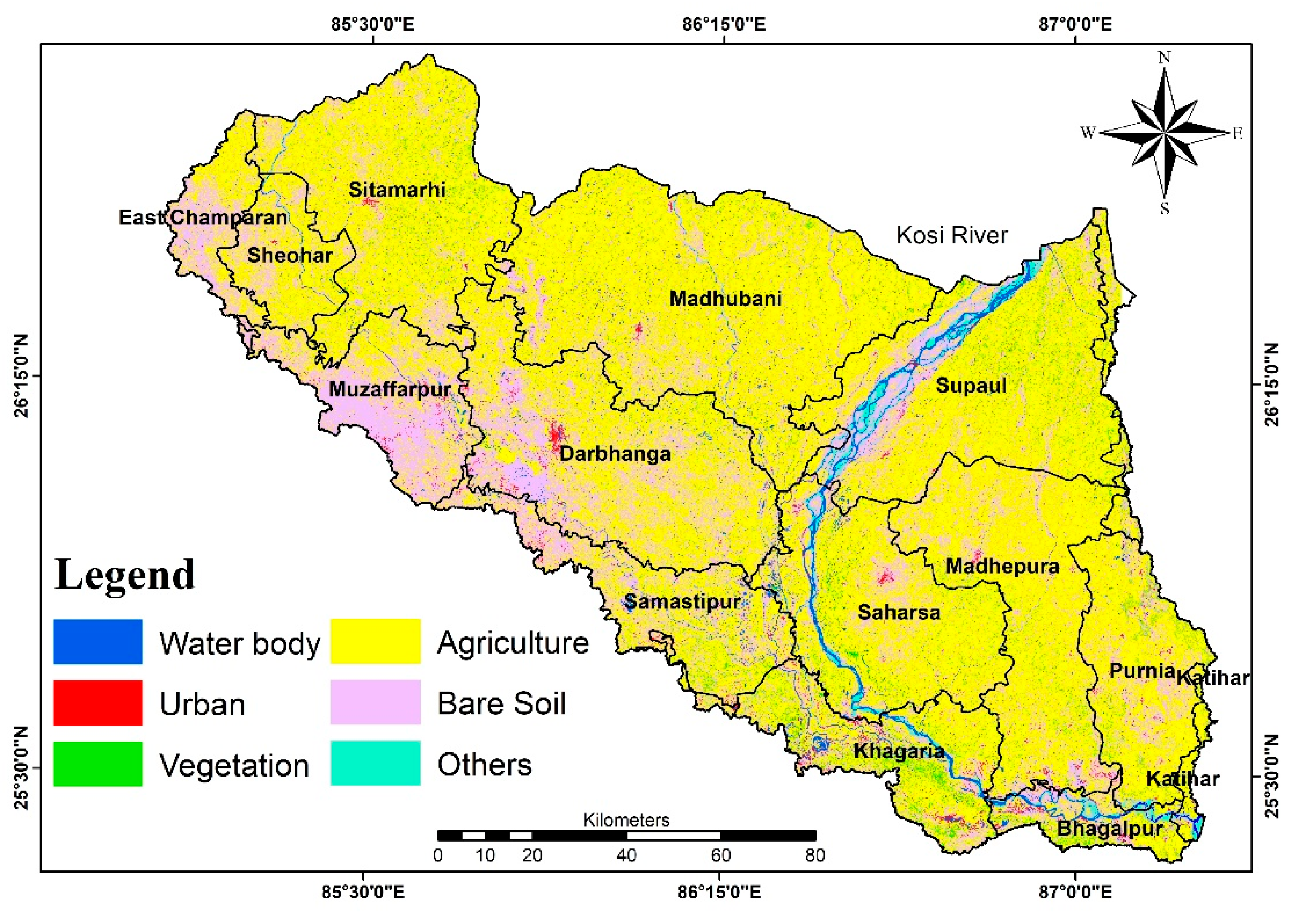
| Site ID | Latitude (° N) | Longitude (° E) | Date (dd-mm-yyy) | Crop Height (cm) | SSM (m3/m3) | Sampling Depth | Land Use |
|---|---|---|---|---|---|---|---|
| S1 | 26.0591 | 86.7101 | 15 February 2021 | 5 | 0.21 | 7.6 cm | Maize |
| S2 | 26.0060 | 86.7735 | 15 February 2021 | 20.2 | 0.365 | 7.6 cm | Maize |
| S3 | 25.8421 | 86.7092 | 15 February 2021 | 11.7 | 0.09 | 7.6 cm | Maize |
| S4 | 25.8761 | 86.5643 | 15 February 2021 | - | 0.055 | 7.6 cm | Bare soil |
| S5 | 26.2646 | 86.7203 | 15 February 2021 | - | 0.54 | 7.6 cm | Bare soil |
| S6 | 26.2647 | 86.7198 | 15 February 2021 | - | 0.385 | 7.6 cm | Bare soil |
| S7 | 26.3261 | 86.6102 | 15 February 2021 | 20 | 0.034 | 7.6 cm | Wheat |
| S8 | 26.3264 | 86.6113 | 15 February 2021 | - | 0.534 | 7.6 cm | Bare soil |
| S9 | 26.3376 | 86.5949 | 15 February 2021 | 23 | 0.209 | 7.6 cm | Wheat |
| S10 | 26.3378 | 86.5947 | 15 February 2021 | 25 | 0.30 | 7.6 cm | Wheat |
| S11 | 26.339 | 86.5949 | 15 February 2021 | - | 0.063 | 7.6 cm | Bare soil |
| S12 | 26.3434 | 86.5948 | 15 February 2021 | 13 | 0.423 | 7.6 cm | Wheat |
| S13 | 26.3295 | 86.4184 | 15 February 2021 | - | 0.192 | 7.6 cm | Bare soil |
| S14 | 26.3158 | 86.0635 | 15 February 2021 | - | 0.185 | 7.6 cm | Bare soil |
| S15 | 26.3155 | 86.063 | 15 February 2021 | - | 0.17 | 7.6 cm | Bare soil |
| S16 | 26.3155 | 86.0633 | 15 February 2021 | 13 | 0.315 | 7.6 cm | Wheat |
| S17 | 26.2703 | 86.0689 | 16 February 2021 | - | 0.207 | 7.6 cm | Bare soil |
| S18 | 26.2845 | 86.064 | 16 February 2021 | 13 | 0.151 | 7.6 cm | Wheat |
| S19 | 26.2593 | 86.071 | 16 February 2021 | 10 | 0.365 | 7.6 cm | Wheat |
| S20 | 26.1733 | 86.6461 | 16 February 2021 | - | 0.497 | 7.6 cm | Bare soil |
| S21 | 26.1955 | 86.6663 | 16 February 2021 | - | 0.31 | 7.6 cm | Bare soil |
| S22 | 26.0796 | 86.6944 | 16 February 2021 | - | 0.169 | 7.6 cm | Bare soil |
| S23 | 26.0801 | 86.6948 | 16 February 2021 | - | 0.146 | 7.6 cm | Bare soil |
| S24 | 26.1157 | 86.6169 | 16 February 2021 | - | 0.449 | 7.6 cm | Bare soil |
| S25 | 26.059 | 86.7097 | 16 February 2021 | 22 | 0.092 | 7.6 cm | Wheat |
| S26 | 26.0019 | 86.7757 | 16 February 2021 | - | 0.043 | 7.6 cm | Bare soil |
| S27 | 26.0018 | 86.7759 | 16 February 2021 | 35 | 0.136 | 7.6 cm | Maize |
| S28 | 26.0064 | 86.7741 | 16 February 2021 | 32 | 0.30 | 7.6 cm | Maize |
| S29 | 25.8835 | 86.5652 | 16 February 2021 | 14 | 0.225 | 7.6 cm | Maize |
| S30 | 25.8833 | 86.6423 | 16 February 2021 | 15 | 0.418 | 7.6 cm | Wheat |
| S31 | 25.8893 | 86.6305 | 16 February 2021 | - | 0.023 | 7.6 cm | Bare soil |
| S32 | 25.8951 | 86.6301 | 16 February 2021 | 22.5 | 0.518 | 7.6 cm | Wheat |
| S33 | 25.8979 | 86.6277 | 17 February 2021 | 9 | 0.107 | 7.6 cm | Wheat |
| S34 | 25.8988 | 86.6241 | 17 February 2021 | - | 0.465 | 7.6 cm | Bare soil |
| S35 | 25.8992 | 86.619 | 17 February 2021 | - | 0.41 | 7.6 cm | Bare soil |
| S36 | 25.8968 | 86.6189 | 17 February 2021 | 17 | 0.287 | 7.6 cm | Maize |
| S37 | 25.8929 | 86.6193 | 17 February 2021 | - | 0.321 | 7.6 cm | Bare soil |
| S38 | 25.892 | 86.619 | 17 February 2021 | 11.65 | 0.112 | 7.6 cm | Maize |
| S39 | 25.8922 | 86.6281 | 17 February 2021 | 20 | 0.203 | 7.6 cm | Maize |
| S40 | 25.8857 | 86.6303 | 17 February 2021 | 17.5 | 0.225 | 7.6 cm | Maize |
| S41 | 25.886 | 86.632 | 17 February 2021 | - | 0.091 | 7.6 cm | Maize |
| S42 | 25.8704 | 86.6607 | 17 February 2021 | - | 0.081 | 7.6 cm | Bare soil |
| S43 | 25.8702 | 86.6616 | 17 February 2021 | 35 | 0.126 | 7.6 cm | Bare soil |
| S44 | 25.8705 | 86.6636 | 17 February 2021 | 25 | 0.295 | 7.6 cm | Maize |
| S45 | 25.8701 | 86.665 | 17 February 2021 | 15 | 0.333 | 7.6 cm | Wheat |
| S46 | 25.8693 | 86.6632 | 18 February 2021 | 35 | 0.211 | 7.6 cm | Wheat |
| S47 | 25.8386 | 86.7072 | 18 February 2021 | - | 0.098 | 7.6 cm | Maize |
| S48 | 25.8432 | 86.7095 | 18 February 2021 | 30.7 | 0.381 | 7.6 cm | Bare soil |
| S49 | 25.8435 | 86.7096 | 18 February 2021 | 32 | 0.385 | 7.6 cm | Maize |
| S50 | 25.8438 | 86.7096 | 18 February 2021 | 30.5 | 0.305 | 7.6 cm | Maize |
| S51 | 25.8438 | 86.7098 | 18 February 2021 | 31 | 0.245 | 7.6 cm | Maize |
| S52 | 25.8718 | 86.5661 | 18 February 2021 | 10 | 0.281 | 7.6 cm | Maize |
| S53 | 25.8739 | 86.5644 | 18 February 2021 | 11 | 0.286 | 7.6 cm | Wheat |
| S54 | 25.8766 | 86.5618 | 18 February 2021 | - | 0.075 | 7.6 cm | Wheat |
References
- Srivastava, P.K.; O’Neill, P.; Cosh, M.; Kurum, M.; Lang, R.; Joseph, A. Evaluation of Dielectric Mixing Models for Passive Microwave Soil Moisture Retrieval Using Data From ComRAD Ground-Based SMAP Simulator. IEEE J. Sel. Top. Appl. Earth Obs. Remote Sens. 2015, 8, 4345–4354. [Google Scholar] [CrossRef]
- Torres-Rua, A.; Ticlavilca, A.; Bachour, R.; McKee, M. Estimation of Surface Soil Moisture in Irrigated Lands by Assimilation of Landsat Vegetation Indices, Surface Energy Balance Products, and Relevance Vector Machines. Water 2016, 8, 167. [Google Scholar] [CrossRef] [Green Version]
- Petropoulos, G.; Srivastava, P.; Piles, M.; Pearson, S. Earth Observation-Based Operational Estimation of Soil Moisture and Evapotranspiration for Agricultural Crops in Support of Sustainable Water Management. Sustainability 2018, 10, 181. [Google Scholar] [CrossRef] [Green Version]
- Zribi, M.; Muddu, S.; Bousbih, S.; Al Bitar, A.; Tomer, S.K.; Baghdadi, N.; Bandyopadhyay, S. Analysis of L-Band SAR Data for Soil Moisture Estimations over Agricultural Areas in the Tropics. Remote Sens. 2019, 11, 1122. [Google Scholar] [CrossRef] [Green Version]
- Sekertekin, A.; Marangoz, A.M.; Abdikan, S. ALOS-2 and Sentinel-1 SAR Data Sensitivity Analysis to Surface Soil Moisture over Bare and Vegetated Agricultural Fields. Comput. Electron. Agric. 2020, 171, 105303. [Google Scholar] [CrossRef]
- Şekertekin, A.; Marangoz, A.M.; Abdikan, S. Soil Moisture Mapping Using Sentinel-1A Synthetic Aperture Radar Data. Int. J. Environ. Geoinform. 2018, 5, 178–188. [Google Scholar] [CrossRef]
- Sadeghi, M.; Babaeian, E.; Tuller, M.; Jones, S.B. The Optical Trapezoid Model: A Novel Approach to Remote Sensing of Soil Moisture Applied to Sentinel-2 and Landsat-8 Observations. Remote Sens. Environ. 2017, 198, 52–68. [Google Scholar] [CrossRef] [Green Version]
- Moghaddam, M.; Entekhabi, D.; Goykhman, Y.; Li, K.; Liu, M.; Mahajan, A.; Nayyar, A.; Shuman, D.; Teneketzis, D. A Wireless Soil Moisture Smart Sensor Web Using Physics-Based Optimal Control: Concept and Initial Demonstrations. IEEE J. Sel. Top. Appl. Earth Obs. Remote Sens. 2010, 3, 522–535. [Google Scholar] [CrossRef]
- Tian, J.; Philpot, W.D. Relationship between Surface Soil Water Content, Evaporation Rate, and Water Absorption Band Depths in SWIR Reflectance Spectra. Remote Sens. Environ. 2015, 169, 280–289. [Google Scholar] [CrossRef]
- Zeng, W.; Xu, C.; Huang, J.; Wu, J.; Tuller, M. Predicting Near-Surface Moisture Content of Saline Soils from Near-Infrared Reflectance Spectra with a Modified Gaussian Model. Soil Sci. Soc. Am. J. 2016, 80, 1496–1506. [Google Scholar] [CrossRef]
- Patel, N.R.; Mukund, A.; Parida, B.R. Satellite-Derived Vegetation Temperature Condition Index to Infer Root Zone Soil Moisture in Semi-Arid Province of Rajasthan, India. Geocarto Int. 2019, 34, 179–195. [Google Scholar] [CrossRef]
- Aubert, M.; Baghdadi, N.N.; Zribi, M.; Ose, K.; El Hajj, M.; Vaudour, E.; Gonzalez-Sosa, E. Toward an Operational Bare Soil Moisture Mapping Using TerraSAR-X Data Acquired Over Agricultural Areas. IEEE J. Sel. Top. Appl. Earth Obs. Remote Sens. 2013, 6, 900–916. [Google Scholar] [CrossRef]
- Bazzi, H.; Baghdadi, N.; El Hajj, M.; Zribi, M.; Belhouchette, H. A Comparison of Two Soil Moisture Products S2MP and Copernicus-SSM Over Southern France. IEEE J. Sel. Top. Appl. Earth Obs. Remote Sens. 2019, 12, 3366–3375. [Google Scholar] [CrossRef]
- Kerr, Y.H.; Waldteufel, P.; Wigneron, J.-P.; Delwart, S.; Cabot, F.; Boutin, J.; Escorihuela, M.-J.; Font, J.; Reul, N.; Gruhier, C.; et al. The SMOS Mission: New Tool for Monitoring Key Elements Ofthe Global Water Cycle. Proc. IEEE 2010, 98, 666–687. [Google Scholar] [CrossRef] [Green Version]
- Brown, M.E.; Escobar, V.; Moran, S.; Entekhabi, D.; O’Neill, P.E.; Njoku, E.G.; Doorn, B.; Entin, J.K. NASA’s Soil Moisture Active Passive (SMAP) Mission and Opportunities for Applications Users. Bull. Am. Meteorol. Soc. 2013, 94, 1125–1128. [Google Scholar] [CrossRef]
- Gorrab, A.; Zribi, M.; Baghdadi, N.; Mougenot, B.; Fanise, P.; Chabaane, Z. Retrieval of Both Soil Moisture and Texture Using TerraSAR-X Images. Remote Sens. 2015, 7, 10098–10116. [Google Scholar] [CrossRef] [Green Version]
- Esetlili, M.T.; Kurucu, Y. Determination of Main Soil Properties Using Synthetic Aperture Radar. Fresenius Environ. Bull. 2016, 25, 23–36. [Google Scholar]
- Yadav, V.P.; Prasad, R.; Bala, R.; Vishwakarma, A.K. An Improved Inversion Algorithm for Spatio-Temporal Retrieval of Soil Moisture through Modified Water Cloud Model Using C- Band Sentinel-1A SAR Data. Comput. Electron. Agric. 2020, 173, 105447. [Google Scholar] [CrossRef]
- Mirsoleimani, H.R.; Sahebi, M.R.; Baghdadi, N.; El Hajj, M. Bare Soil Surface Moisture Retrieval from Sentinel-1 SAR Data Based on the Calibrated IEM and Dubois Models Using Neural Networks. Sensors 2019, 19, 3209. [Google Scholar] [CrossRef] [Green Version]
- Bindlish, R.; Barros, A.P. Parameterization of Vegetation Backscatter in Radar-Based, Soil Moisture Estimation. Remote Sens. Environ. 2001, 76, 130–137. [Google Scholar] [CrossRef]
- Le Hegarat-Mascle, S.; Zribi, M.; Alem, F.; Weisse, A.; Loumagne, C. Soil Moisture Estimation from ERS/SAR Data: Toward an Operational Methodology. IEEE Trans. Geosci. Remote Sens. 2002, 40, 2647–2658. [Google Scholar] [CrossRef]
- Aubert, M.; Baghdadi, N.; Zribi, M.; Douaoui, A.; Loumagne, C.; Baup, F.; El Hajj, M.; Garrigues, S. Analysis of TerraSAR-X Data Sensitivity to Bare Soil Moisture, Roughness, Composition and Soil Crust. Remote Sens. Environ. 2011, 115, 1801–1810. [Google Scholar] [CrossRef] [Green Version]
- Dave, R.; Kumar, G.; Pandey, D.K.; Khan, A.; Bhattacharya, B. Evaluation of Modified Dubois Model for Estimating Surface Soil Moisture Using Dual Polarization RISAT-1 C-Band SAR Data. Geocarto Int. 2021, 36, 1459–1469. [Google Scholar] [CrossRef]
- El Hajj, M.; Baghdadi, N.; Zribi, M. Comparative Analysis of the Accuracy of Surface Soil Moisture Estimation from the C- and L-Bands. Int. J. Appl. Earth Obs. Geoinf. 2019, 82, 101888. [Google Scholar] [CrossRef]
- Anguela, T.P.; Zribi, M.; Baghdadi, N.; Loumagne, C. Analysis of Local Variation of Soil Surface Parameters With TerraSAR-X Radar Data Over Bare Agricultural Fields. IEEE Trans. Geosci. Remote Sens. 2010, 48, 874–881. [Google Scholar] [CrossRef]
- Hosseini, R.; Newlands, N.; Dean, C.; Takemura, A. Statistical Modeling of Soil Moisture, Integrating Satellite Remote-Sensing (SAR) and Ground-Based Data. Remote Sens. 2015, 7, 2752–2780. [Google Scholar] [CrossRef] [Green Version]
- Fernández-Prieto, D.; Kesselmeier, J.; Ellis, M.; Marconcini, M.; Reissell, A.; Suni, T. Earth Observation for Land-Atmosphere Interaction Science. Biogeosciences 2013, 10, 261–266. [Google Scholar] [CrossRef]
- Grillakis, M.G.; Koutroulis, A.G.; Komma, J.; Tsanis, I.K.; Wagner, W.; Blöschl, G. Initial Soil Moisture Effects on Flash Flood Generation—A Comparison between Basins of Contrasting Hydro-Climatic Conditions. J. Hydrol. 2016, 541, 206–217. [Google Scholar] [CrossRef]
- Fung, A.K.; Li, Z.; Chen, K.S. Backscattering from a Randomly Rough Dielectric Surface. IEEE Trans. Geosci. Remote Sens. 1992, 30, 356–369. [Google Scholar] [CrossRef]
- Oh, Y.; Sarabandi, K.; Ulaby, F.T. An Empirical Model and an Inversion Technique for Radar Scattering from Bare Soil Surfaces. IEEE Trans. Geosci. Remote Sens. 1992, 30, 370–381. [Google Scholar] [CrossRef]
- Das, K.; Paul, P.K. Soil Moisture Retrieval Model by Using RISAT-1, C-Band Data in Tropical Dry and Sub-Humid Zone of Bankura District of India. Egypt. J. Remote Sens. Space Sci. 2015, 18, 297–310. [Google Scholar] [CrossRef] [Green Version]
- Dubois, P.C.; van Zyl, J.; Engman, T. Measuring Soil Moisture with Imaging Radars. IEEE Trans. Geosci. Remote Sens. 1995, 33, 915–926. [Google Scholar] [CrossRef] [Green Version]
- Oh, Y. Quantitative Retrieval of Soil Moisture Content and Surface Roughness From Multipolarized Radar Observations of Bare Soil Surfaces. IEEE Trans. Geosci. Remote Sens. 2004, 42, 596–601. [Google Scholar] [CrossRef]
- Petropoulos, G.P.; Ireland, G.; Barrett, B. Surface Soil Moisture Retrievals from Remote Sensing: Current Status, Products & Future Trends. Phys. Chem. Earth Parts A/B/C 2015, 83–84, 36–56. [Google Scholar] [CrossRef]
- Kumar, K.; Suryanarayana Rao, H.P.; Arora, M.K. Study of Water Cloud Model Vegetation Descriptors in Estimating Soil Moisture in Solani Catchment. Hydrol. Process. 2015, 29, 2137–2148. [Google Scholar] [CrossRef]
- Bao, Y.; Lin, L.; Wu, S.; Kwal Deng, K.A.; Petropoulos, G.P. Surface Soil Moisture Retrievals over Partially Vegetated Areas from the Synergy of Sentinel-1 and Landsat 8 Data Using a Modified Water-Cloud Model. Int. J. Appl. Earth Obs. Geoinf. 2018, 72, 76–85. [Google Scholar] [CrossRef]
- Baghdadi, N.; El Hajj, M.; Zribi, M.; Bousbih, S. Calibration of the Water Cloud Model at C-Band for Winter Crop Fields and Grasslands. Remote Sens. 2017, 9, 969. [Google Scholar] [CrossRef] [Green Version]
- Bai, X.; He, B. Potential of Dubois Model for Soil Moisture Retrieval in Prairie Areas Using SAR and Optical Data. Int. J. Remote Sens. 2015, 36, 5737–5753. [Google Scholar] [CrossRef]
- Du, J.; Shi, J.; Sun, R. The Development of HJ SAR Soil Moisture Retrieval Algorithm. Int. J. Remote Sens. 2010, 31, 3691–3705. [Google Scholar] [CrossRef]
- Fung, A.K. Microwave Scattering and Emission Models and Their Applications; Artech House: Norwood, MA, USA, 1994. [Google Scholar]
- Zribi, M.; Baghdadi, N.; Holah, N.; Fafin, O. New Methodology for Soil Surface Moisture Estimation and Its Application to ENVISAT-ASAR Multi-Incidence Data Inversion. Remote Sens. Environ. 2005, 96, 485–496. [Google Scholar] [CrossRef]
- Gorrab, A.; Zribi, M.; Baghdadi, N.; Mougenot, B.; Chabaane, Z. Potential of X-Band TerraSAR-X and COSMO-SkyMed SAR Data for the Assessment of Physical Soil Parameters. Remote Sens. 2015, 7, 747–766. [Google Scholar] [CrossRef] [Green Version]
- Singh, A.; Gaurav, K.; Kumar, S. Evaluating the Potential of Sentinel-1 Images for the Estimation of Soil Moisture on an Alluvial Fan. In Proceedings of the EGU General Assembly 2020, EGU2020-19614, Online, 4–8 May 2020. [Google Scholar]
- Kumar, P.; Prasad, R.; Choudhary, A.; Gupta, D.K.; Mishra, V.N.; Vishwakarma, A.K.; Singh, A.K.; Srivastava, P.K. Comprehensive Evaluation of Soil Moisture Retrieval Models under Different Crop Cover Types Using C-Band Synthetic Aperture Radar Data. Geocarto Int. 2019, 34, 1022–1041. [Google Scholar] [CrossRef]
- Njoku, E.G.; Wilson, W.J.; Yueh, S.H.; Dinardo, S.J.; Li, F.K.; Jackson, T.J.; Lakshmi, V.; Bolten, J. Observations of Soil Moisture Using a Passive and Active Low-Frequency Microwave Airborne Sensor during SGP99. IEEE Trans. Geosci. Remote Sens. 2002, 40, 2659–2673. [Google Scholar] [CrossRef]
- Das, N.N.; Entekhabi, D.; Njoku, E.G. An Algorithm for Merging SMAP Radiometer and Radar Data for High-Resolution Soil-Moisture Retrieval. IEEE Trans. Geosci. Remote Sens. 2011, 49, 1504–1512. [Google Scholar] [CrossRef]
- Zhan, X.; Houser, P.R.; Walker, J.P.; Crow, W.T. A Method for Retrieving High-Resolution Surface Soil Moisture from Hydros L-Band Radiometer and Radar Observations. IEEE Trans. Geosci. Remote Sens. 2006, 44, 1534–1544. [Google Scholar] [CrossRef]
- Parida, B.R.; Tripathi, G.; Pandey, A.C.; Kumar, A. Estimating Floodwater Depth Using SAR-Derived Flood Inundation Maps and Geomorphic Model in Kosi River Basin (India). Geocarto Int. 2021, 1–26. [Google Scholar] [CrossRef]
- Tripathi, G.; Pandey, A.C.; Parida, B.R. Flood Hazard and Risk Zonation in North Bihar Using Satellite-Derived Historical Flood Events and Socio-Economic Data. Sustainability 2022, 14, 1472. [Google Scholar] [CrossRef]
- Tripathi, G.; Parida, B.R.; Pandey, A.C. Spatio-Temporal Rainfall Variability and Flood Prognosis Analysis Using Satellite Data over North Bihar during the August 2017 Flood Event. Hydrology 2019, 6, 38. [Google Scholar] [CrossRef] [Green Version]
- Tripathi, G.; Pandey, A.C.; Parida, B.R.; Kumar, A. Flood Inundation Mapping and Impact Assessment Using Multi-Temporal Optical and SAR Satellite Data: A Case Study of 2017 Flood in Darbhanga District, Bihar, India. Water Resour. Manag. 2020, 34, 1871–1892. [Google Scholar] [CrossRef]
- Pandey, A.C.; Kaushik, K.; Parida, B.R. Google Earth Engine for Large-Scale Flood Mapping Using SAR Data and Impact Assessment on Agriculture and Population of Ganga-Brahmaputra Basin. Sustainability 2022, 14, 4210. [Google Scholar] [CrossRef]
- Tesfaye, K.; Aggarwal, P.; Mequanint, F.; Shirsath, P.; Stirling, C.; Khatri-Chhetri, A.; Rahut, D. Climate Variability and Change in Bihar, India: Challenges and Opportunities for Sustainable Crop Production. Sustainability 2017, 9, 1998. [Google Scholar] [CrossRef] [Green Version]
- Pandey, A.C.; Singh, S.K.; Nathawat, M.S. Waterlogging and Flood Hazards Vulnerability and Risk Assessment in Indo Gangetic Plain. Nat. Hazards 2010, 55, 273–289. [Google Scholar] [CrossRef]
- Rao, S.; Kumar, D.S.; Das, S.N.; Nagaraju, M.S.S.; Venugopal, M.V.; Rajankar, P.; Laghate, P.; Reddy, M.S.; Joshi, A.K.; Sharma, J.R. Modified Dubois Model for Estimating Soil Moisture with Dual Polarized SAR Data. J. Indian Soc. Remote Sens. 2013, 41, 865–872. [Google Scholar] [CrossRef]
- Topp, G.C.; Davis, J.L.; Annan, A.P. Electromagnetic Determination of Soil Water Content: Measurements in Coaxial Transmission Lines. Water Resour. Res. 1980, 16, 574–582. [Google Scholar] [CrossRef] [Green Version]
- Bauer-Marschallinger, B.; Freeman, V.; Cao, S.; Paulik, C.; Schaufler, S.; Stachl, T.; Modanesi, S.; Massari, C.; Ciabatta, L.; Brocca, L.; et al. Toward Global Soil Moisture Monitoring With Sentinel-1: Harnessing Assets and Overcoming Obstacles. IEEE Trans. Geosci. Remote Sens. 2019, 57, 520–539. [Google Scholar] [CrossRef]
- Singh, A.; Gaurav, K.; Rai, A.K.; Beg, Z. Machine Learning to Estimate Surface Roughness from Satellite Images. Remote Sens. 2021, 13, 3794. [Google Scholar] [CrossRef]
- Song, K.; Zhou, X.; Fan, Y. Empirically Adopted IEM for Retrieval of Soil Moisture From Radar Backscattering Coefficients. IEEE Trans. Geosci. Remote Sens. 2009, 47, 1662–1672. [Google Scholar] [CrossRef]
- Sinha, R. The Kosi Megafan: The Best-Known Himalayan Megafan. In Landscapes and Landforms of India; Kale, V.S., Ed.; World Geomorphological Landscapes; Springer: Dordrecht, The Netherlands, 2014; pp. 151–156. ISBN 978-94-017-8028-5. [Google Scholar]
- Singh, A.; Gaurav, K.; Meena, G.K.; Kumar, S. Estimation of Soil Moisture Applying Modified Dubois Model to Sentinel-1; A Regional Study from Central India. Remote Sens. 2020, 12, 2266. [Google Scholar] [CrossRef]
- Merzouki, A.; McNairn, H.; Pacheco, A. Mapping Soil Moisture Using RADARSAT-2 Data and Local Autocorrelation Statistics. IEEE J. Sel. Top. Appl. Earth Obs. Remote Sens. 2011, 4, 128–137. [Google Scholar] [CrossRef]
- Huang, X.; Ziniti, B.; Cosh, M.H.; Reba, M.; Wang, J.; Torbick, N. Field-Scale Soil Moisture Retrieval Using PALSAR-2 Polarimetric Decomposition and Machine Learning. Agronomy 2020, 11, 35. [Google Scholar] [CrossRef]
- Said, S. Modeling Surface Soil Moisture from Microwave Remote Sensing Data in Solani River Catchment, Uttarakhand, India. J. Geogr. Stud. 2017, 1, 3–10. [Google Scholar] [CrossRef]
- Gururaj, P.; Umesh, P.; Shetty, A. Modeling of Surface Soil Moisture Using C-Band SAR Data over Bare Fields in the Tropical Semi-Arid Region of India. Appl. Geomat. 2021, 13, 555–564. [Google Scholar] [CrossRef]
- Said, S.; Kothyari, U.C.; Arora, M.K. ANN-Based Soil Moisture Retrieval over Bare and Vegetated Areas Using ERS-2 SAR Data. J. Hydrol. Eng. 2008, 13, 461–475. [Google Scholar] [CrossRef]
- Paloscia, S.; Pettinato, S.; Santi, E.; Notarnicola, C.; Pasolli, L.; Reppucci, A. Soil Moisture Mapping Using Sentinel-1 Images: Algorithm and Preliminary Validation. Remote Sens. Environ. 2013, 134, 234–248. [Google Scholar] [CrossRef]
- El Hajj, M.; Baghdadi, N.; Zribi, M.; Belaud, G.; Cheviron, B.; Courault, D.; Charron, F. Soil Moisture Retrieval over Irrigated Grassland Using X-Band SAR Data. Remote Sens. Environ. 2016, 176, 202–218. [Google Scholar] [CrossRef] [Green Version]
- Hajnsek, I.; Jagdhuber, T.; Schon, H.; Papathanassiou, K.P. Potential of Estimating Soil Moisture Under Vegetation Cover by Means of PolSAR. IEEE Trans. Geosci. Remote Sens. 2009, 47, 442–454. [Google Scholar] [CrossRef] [Green Version]
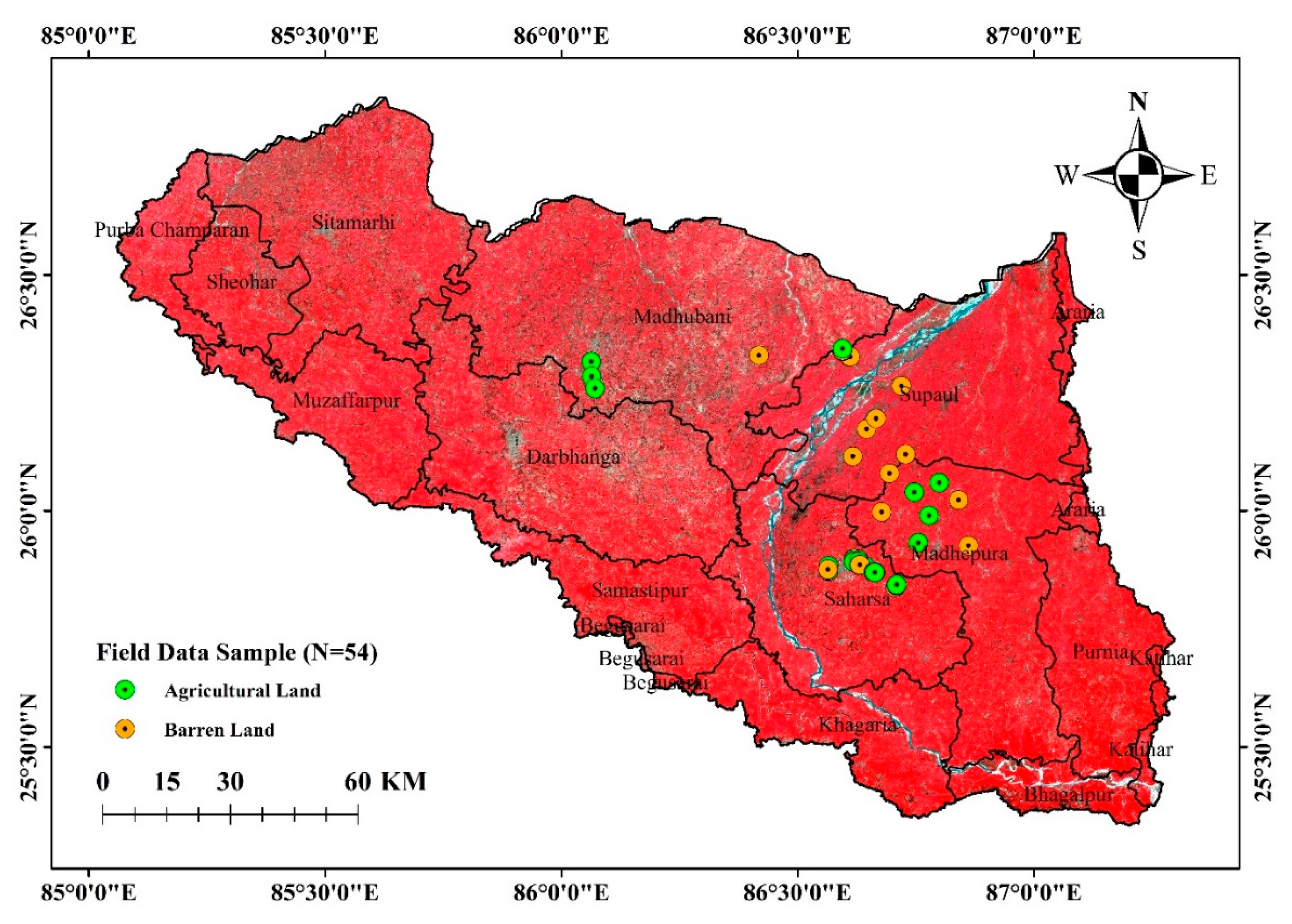
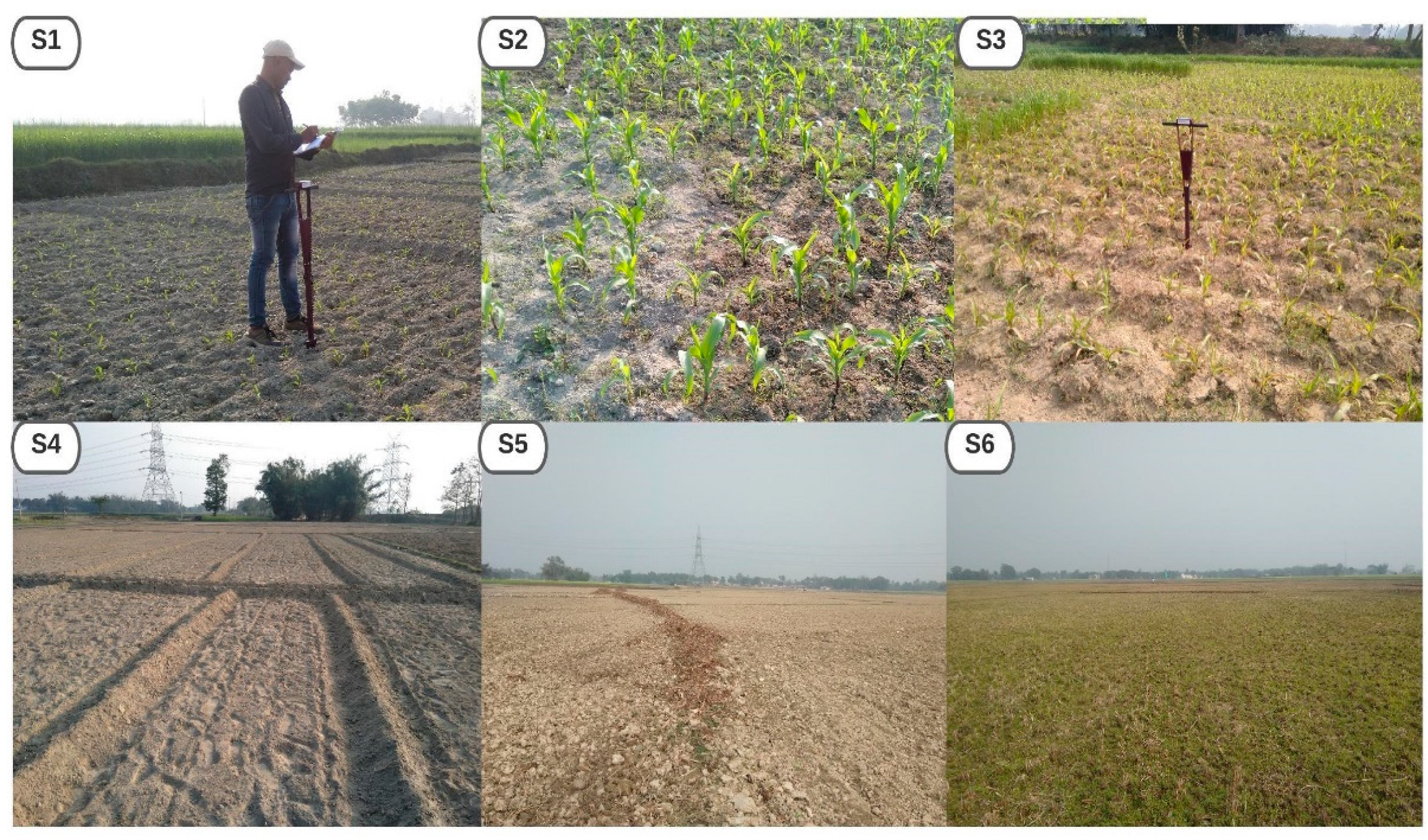
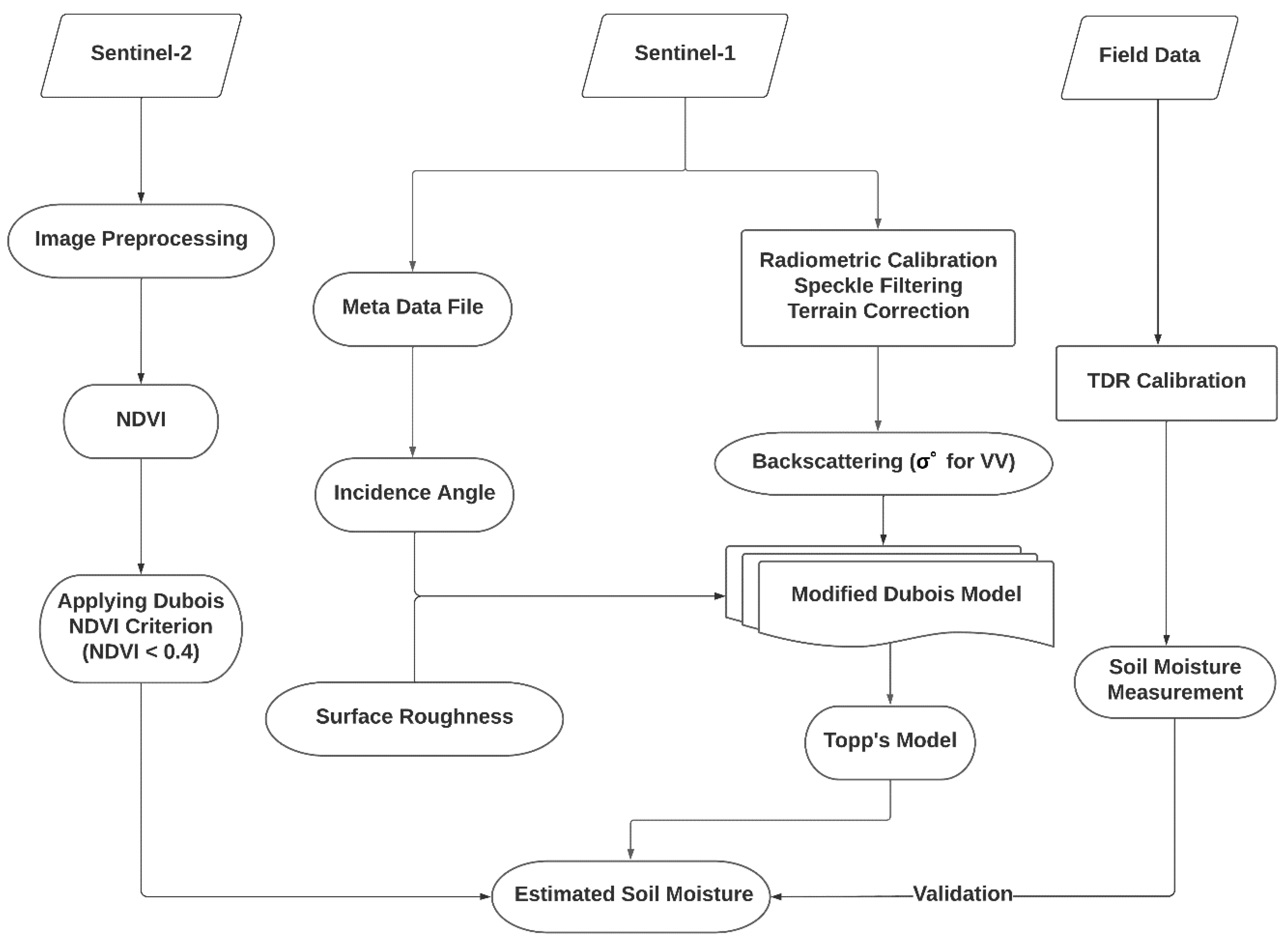
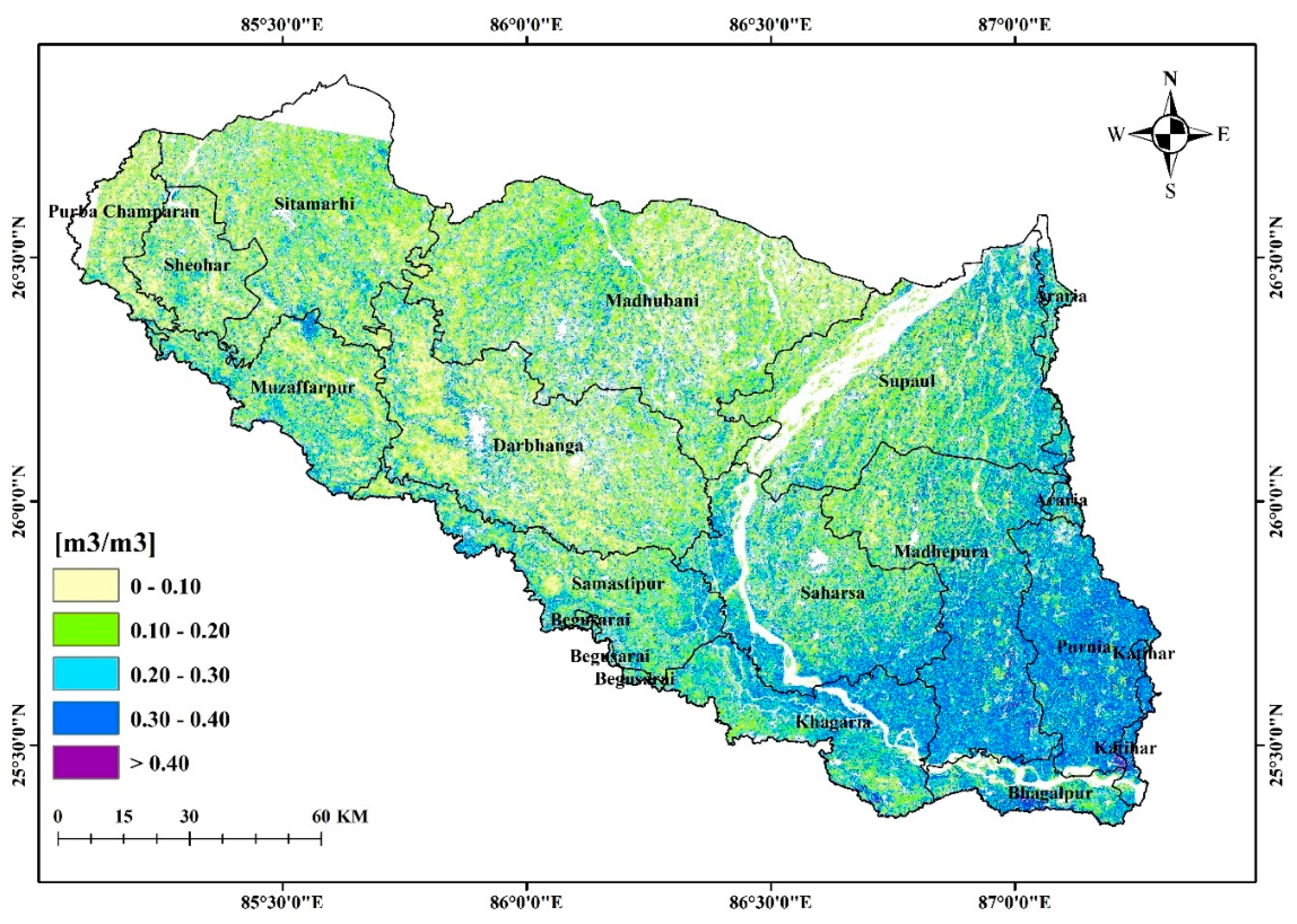
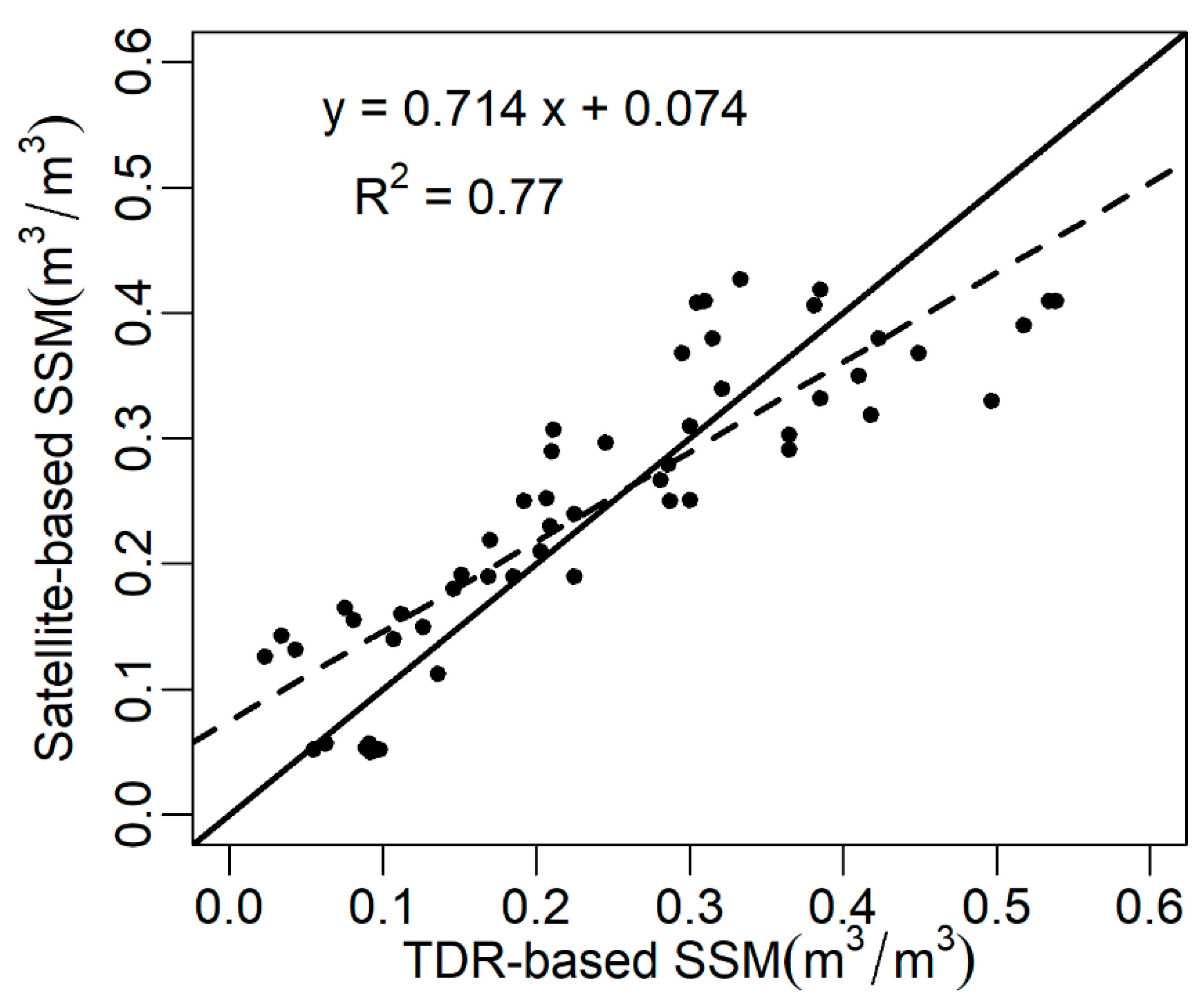
| Data Used | Acquisition | Characteristics | Purpose |
|---|---|---|---|
| Sentinel-1A (VV) | 15 February 2021 (descending) | 10 m × 10 m Incidence angle: 38.39° | Soil Moisture |
| Sentinel-2B | 16 February 2021 | 10 m × 10 m Bands: 4 and 8 | NDVI |
| Acquisition | Tmax (°C) | Tmin (°C) | Rainfall (mm) | ||
|---|---|---|---|---|---|
| Supaul | Muzaffarpur | Supaul | Muzaffarpur | ||
| 15 February 2021 | 27.9 | 25.4 | 15.4 | 14.6 | 0 |
| 16 February 2021 | 27.0 | 25.6 | 14.2 | 14.6 | 0 |
| 17 February 2021 | 26.5 | 26.6 | 15.7 | 15.7 | 0 |
| 18 February 2021 | 27.9 | 25.6 | 16.0 | 16.7 | 0 |
| LULC | SSM (m3/m3) | Crop Height (cm) | ||
|---|---|---|---|---|
| Mean (Min–Max) | SD, CV | Mean (Min–Max) | SD, CV | |
| Bare soil | 0.23 (0.017–0.586) | 0.04, 0.17 | – | – |
| Agricultural fields (maize, wheat) | 0.25 (0.022–0.598) | 0.05, 0.20 | 20 (5–35) | 7.93, 0.44 |
Publisher’s Note: MDPI stays neutral with regard to jurisdictional claims in published maps and institutional affiliations. |
© 2022 by the authors. Licensee MDPI, Basel, Switzerland. This article is an open access article distributed under the terms and conditions of the Creative Commons Attribution (CC BY) license (https://creativecommons.org/licenses/by/4.0/).
Share and Cite
Parida, B.R.; Pandey, A.C.; Kumar, R.; Kumar, S. Surface Soil Moisture Retrieval Using Sentinel-1 SAR Data for Crop Planning in Kosi River Basin of North Bihar. Agronomy 2022, 12, 1045. https://doi.org/10.3390/agronomy12051045
Parida BR, Pandey AC, Kumar R, Kumar S. Surface Soil Moisture Retrieval Using Sentinel-1 SAR Data for Crop Planning in Kosi River Basin of North Bihar. Agronomy. 2022; 12(5):1045. https://doi.org/10.3390/agronomy12051045
Chicago/Turabian StyleParida, Bikash Ranjan, Arvind Chandra Pandey, Randhir Kumar, and Sourav Kumar. 2022. "Surface Soil Moisture Retrieval Using Sentinel-1 SAR Data for Crop Planning in Kosi River Basin of North Bihar" Agronomy 12, no. 5: 1045. https://doi.org/10.3390/agronomy12051045






